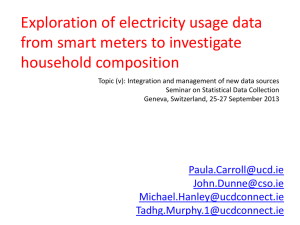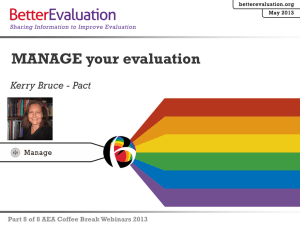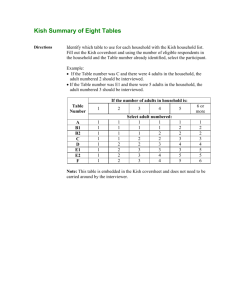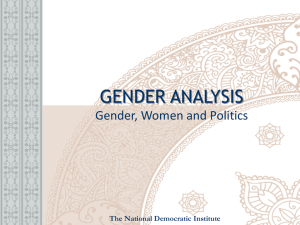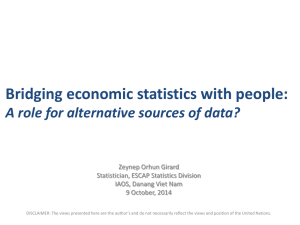Module 3: Strengthening Property Rights of Women Presentation
advertisement
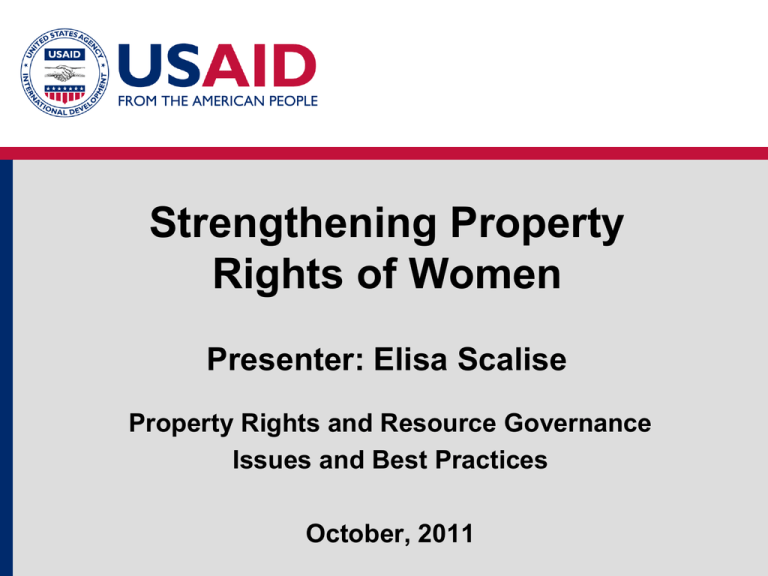
Strengthening Property Rights of Women Presenter: Elisa Scalise Property Rights and Resource Governance Issues and Best Practices October, 2011 Objectives Why do we need to specifically focus on strengthening women’s land tenure and property rights? What programmatic approaches exist for strengthening women's rights to land and resources, while still respecting local institutions and customs? 2 What do we know about secure land rights? Positive relationship between secure land rights and increased agricultural productivity/increases in income. Photo credit : Keliang Zhu BUT, increased agricultural activity/income may not lead to decrease in household poverty or to improved family nutrition BECAUSE it matters who within the household has secure land rights 3 Illustration: South Asian enigma India: Fastest growing economy, half of the children are underweight. • India has one of the highest rates of malnutrition in the world and nearly double the rate of sub-Saharan Africa. (IDS 2007) • India’s per capita gross domestic product grew fourfold between 1992 and 2006 yet the percentage of children age 3 and under who are underweight declined from 52% to only 46% nationally, and actually increased in some states. 4 Looking within the household… • Women are more likely than men to spend income from family resources (including land) on children’s nutrition and education. (Quisumbing 1996) • Increase in female landholdings associated with increase in household food expenditure (Central America). (Katz and Chamorro 2002) • Children of mothers who own land less likely to be severely underweight because women have control over household decisions (Nepal). (Allendorf 2006) • Positive relationship between amount of assets a woman has at time of marriage and share of household expenditures on food, education, health care, and children’s clothing. (Quisumbing and Maluccio 2002) 5 Linking to other development challenges… • HIVAIDs stigma resulted in 90 percent of widows studied evicted from the marital home; 79 percent reported being denied a share of their husband’s estate (India). (NACO, NCAER and UNDP 2006) • Study found that where husband died to HIVAIDs, 44 percent of widows interviewed lost cattle, 28 percent lost small livestock live-stock and 41 percent lost farm equipment to in-laws. (FAO 2003) • Women’s property ownership linked to lower risk of marital violence (India). (Panda 2005) 6 Women’s land rights framework 7 “Rights” What rights are we talking about? • Ownership, access, use, transfer, gift, receive, “license”, rent, lease, inherit, bequeath, etc. • Rights obtained via marriage relationship • Joint/individual/communal • Formal/informal; statutory/customary Photo credit : Espinosa 8 “Secure” land rights for women: • Are legally and socially recognized • Are able to withstand changes in the family and in the community • Are long-term • Are enforceable • Exercising them does not require consultation or approval beyond that which is asked of men Photo credit : Espinosa 9 “Insecure” land rights for women/barriers • Cultural or legal prohibitions to acquiring land via markets, inheritance, transfer, or gift (individually or jointly) • Gender differences in customs around marriage, death, inheritance, marital residence • Gender differences in how different types of land rights, are allocated, held, recognized, managed, etc. • Discriminatory laws and policies at central or local level; poorly drafted regulations • Failure of “implementation” of laws • Lack of awareness, information, and enforcement • Gender differences in social roles, structures, access10 What is being done? Law and policy • Tanzania: Village Land Act grants customary rights to families and protects the right of women to acquire hold use and deal with land to the same extent and subject to the same restrictions as any man. (Article 3(2) 1999) • Mozambique: Constitution, family law and land laws all provide that women have equal rights to land and women are joint owners of land held under community title. (See FAO 2010) • Bolivia: 1996 land reform law explicitly recognizes equal rights to land by women and man, independent of their civil status (no need to be married or household head). (Ley No. 1715, Art 3) 11 What is being done? Land administration • Guatemala and India: State-sponsored land programs require land documents be in the name of both spouses or in the name of the female only. (Deere and Magdalena, 2001) • India: Ownership rights for women encouraged by incentives offered at state and local government levels, including reduced stamp duty rate for land registered jointly or in the name of the woman alone. (DPGR 2006) • Ethiopia: Photographs of spouses on joint title deeds to secure women’s land rights in marriage. (USAID 2008) • Indonesia: community driven adjudication of parcel boundaries destroyed by 2004 tsunami helped ensure women’s rights also recognized. (World Bank 2011) 12 What is being done? Improved access Photo credit: : Espinosa • Women Land Access Trusts provide financial intermediation for poor urban women to access land, housing mortgage finance and training in Kenya, Burundi, Uganda, Ghana, Tanzania. (WLAT, UN-Habitat) • Kenya: Advocated for women’s property rights through local tribal elders, helping widows with HIV to regain control over land and family property. – Assisted with legal costs for women seeking redress through courts (USAID Kenya 2009) 13 Approaches to consider in programming • Support legislative reforms that build on local tenure systems that secure women’s rights to land. • Understand how land laws, family laws, regulations, procedures intersect and impact women’s land rights. • Identify all property rights holders within households, and rights other than ownership. • Understand what women and men want/think feasible • Support rights awareness for men, women, and local leaders/influential people. Photo credit: : RDI 14 Approaches to consider in programming • Help provide legal recourse when rights are violated (ADR, customary institutions, paralegals). • Provide incentives and motivation to project personnel, local authorities, and stakeholders for gender integration. Photo credit: : RDI • Monitor impact of land rights related reforms on men and women; make midcourse adjustments. 15

